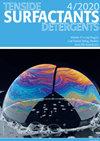聚氧乙烯(20)十六烷基醚在评价生物医学重要化合物疏水性和微乳药物释放过程中的应用
IF 1.2
4区 工程技术
Q4 CHEMISTRY, APPLIED
引用次数: 0
摘要
基于微乳的人工膜的创建和研究是一个重要的方向,因为直接微乳和反向微乳的结构与细胞膜相似。由非离子表面活性剂与C18型固定相结合制备的微乳液流动相在色谱柱中产生类似的细胞膜图像。此外,使用微乳系统将低生物利用度的药物输送到体内可以提高其生物利用度。采用含聚氧乙烯(20)十六烷基醚的胶束流动相,在浓度范围为1 ~ 5%的生物分割胶束色谱(BMC)中,研究了生物医学重要模型物质的色谱行为。将胆酸引入聚氧乙烯(20)十六烷基醚胶束流动相中,以近似细胞膜结构。对模型化合物的疏水性进行了评价。比较了添加和不添加胆酸时胶束流动相的疏水性指数。研究了单体表面活性剂和聚合物表面活性剂微乳液体系中盐酸异丙嗪的释放规律。计算了微乳液体系中盐酸异丙嗪的释放动力学性质。结果表明,聚氧乙烯(20)十六烷基醚与聚氧乙烯(4)十二烷基醚的微乳液可使盐酸异丙嗪的释放量按重量百分比降低。微乳中盐酸异丙嗪的释放不服从菲克扩散,而是遵循非菲克输运机制,扩散指数(n >0.5)。本文章由计算机程序翻译,如有差异,请以英文原文为准。
The use of polyoxyethylene (20) cetyl ether in assessing the hydrophobicity of compounds of biomedical importance and in the process of drug release from microemulsions
Abstract The creation and study of artificial membranes based on microemulsions is an important direction due to the similarity of the structure of both direct and reverse microemulsions with cell membranes. A microemulsion mobile phase prepared with a non-ionic surfactant in combination with a C18 type stationary phase creates a similar image of the cell membrane in a chromatographic column. In addition, the use of microemulsion systems to transport drugs with low bioavailability into the body can increase their bioavailability. The chromatographic behaviour of model substances of biomedical importance was investigated using micellar mobile phases containing polyoxyethylene (20) cetyl ether in biopartitioning micellar chromatography (BMC) in the concentration range of 1–5 %. Cholic acid was introduced into the polyoxyethylene (20) cetyl ether micellar mobile phase to approximate the structure of the cell membrane. The hydrophobicity of the model compounds was evaluated. Hydrophobicity indices in the micellar mobile phase with and without addition of cholic acid were compared. The release profile of promethazine hydrochloride from microemulsion systems with monomeric and polymeric surfactants was investigated. The kinetic properties of the release of promethazine hydrochloride from microemulsion systems were calculated. It was found that a microemulsion of polyoxyethylene (20) cetyl ether mixed with polyoxyethylene (4) lauryl ether reduced the release of promethazine hydrochloride in weight percent. The release of promethazine hydrochloride from microemulsions does not obey Fick’s diffusion but follows a non-Fick’s transport mechanism, as evidenced by the high values of the diffusion exponent ( n > 0.5).
求助全文
通过发布文献求助,成功后即可免费获取论文全文。
去求助
来源期刊

Tenside Surfactants Detergents
工程技术-工程:化工
CiteScore
1.90
自引率
10.00%
发文量
57
审稿时长
3.8 months
期刊介绍:
Tenside Surfactants Detergents offers the most recent results of research and development in all fields of surfactant chemistry, such as: synthesis, analysis, physicochemical properties, new types of surfactants, progress in production processes, application-related problems and environmental behavior. Since 1964 Tenside Surfactants Detergents offers strictly peer-reviewed, high-quality articles by renowned specialists around the world.
 求助内容:
求助内容: 应助结果提醒方式:
应助结果提醒方式:


